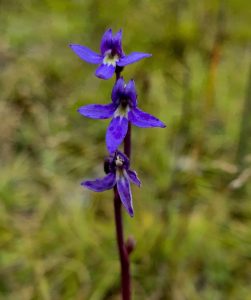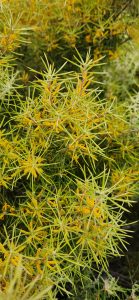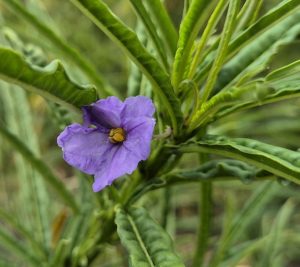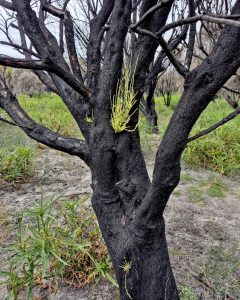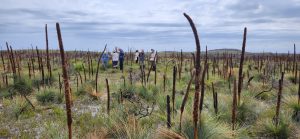Waterhouse Recovers Spectacularly.
Twelve months ago, the Waterhouse Conservation Area was ravaged by a very hot bush fire caused by dry lightning. Everything above the ground was burnt, reducing the colour palette to black, brown and grey.
Afterwards, the area was closed to the public while Parks and Wildlife teams did repairs. Homestead Road was re-sheeted, culverts were cleaned out and many overhanging burnt trees were cleared away.
The Club’s most recent outing was to investigate if and how vegetation recovery was taking place. Some members had visited the area in spring to admire the spectacular display of Kangaroo tails or grass trees. These had been expected to recover after fire as were many other grasses, lilies, rushes and sedges whose dormant buds, roots and lignotubers are somewhat protected from the fire by the soil. We saw Lomandra longifolia, sagg; Diplarrena moraea, the flag iris and of course, Xanthorrhoea australis, the grass tree all beginning their recovery.
- Grass trees in the background and flag iris in the foreground. November 2024 (JW)
- Lomandra longifolia (LB)
There are other ways plants are affected by fire. Eucalypts have epicormic buds under the bark which, after the fire, will produce new shoots down the trunk from the fire damaged tops. In the case of wattles, heat can cause the seeds to pop out of their pods and it can also break the dormancy of seeds already in the soil. With the coastal banksia and the tea tree, fire causes the opening of woody fruits releasing seeds onto the soil surface after the fire has passed.
At our first stop, the situation looked dismal; bare sandy soil, blackened branches and trunks. But, as we stood there, swapping fire recovery stories provided by Ross, Jay and Ian, we looked around us on the ground and saw a myriad of tiny plants. Banksias are the most prevalent, but there are also lomandras, lobelias, milkmaids, pigface, paper daisies, cudweed and guinea flowers all starting to flourish. One unusual and very striking purple plant was Lobelia gibbosa the tall lobelia, a first timer for many. Fiona provided a photo of Persoonia juniperina, the prickly geebung from this site. So, all in all, quite a selection of young plants beginning a new life.
- Lobelia gibbosa (RC)
- Persoonia juniperina (F.F.)
Further on, and looking south from Blizzards Landing, the landscape also looks bleak. One Tree Hill was once covered with a lush forest of Allocasuarina litteralis, drooping she-oaks, and a thick layer of leaf litter [needles] on the ground. There were also low growing plants like native cranberry, ants delight, and everlasting daisies here and there. Nothing had escaped the fire.
In 2023, the last time the Field Nats walked the length of the dune behind Blizzards landing, it was noted there was an extensive wildflower garden with rosy baekea, the native cranberry and silky guinea flowers everywhere. A most diverse vegetation, said to number 400 species and be the richest in the state.
But on the ground here now, the dominant recovery plant is the kangaroo apple. Solanum laciniatum, are often among the first plants to colonise after fire. In pre-fire times, this plant is not seen here. During the fire event the seeds, which must have been dormant in the soil, were activated to spring to life. It is everywhere.
- The kangaroo apple is colonising the burnt she-oak forest (RC)
- Allocasuarina verticillata – epicormic sprouting (RC)
The usual way for casuarinas to deal with fire is for the seed capsules to spit seeds onto the ground and new plants to grow when it rains. But in Ross’s photo you will see an unusual sight of new growth coming from epicormic buds beneath the bark of a she-oak, a phenomenon which is common with Eucalypts, but not she-oaks.
One’s first reaction to a serious fire like this could be one of doom and gloom, but we were reminded by Ian that there are always two sides to the issue ……. Apparently, the Roman God Janus is depicted as having two heads, one looking forward, the other looking backward.
At Waterhouse, looking forward, it would be fair to say recovery is on the way.
Fire was not included in the story of Little Waterhouse Lake, where we retreated for the shade and comfort it offered as a lunch site. This Ramsar Wetland was named because of its abundance of aquatic plants and other notable flora and fauna.
Contributing to this Ramsar listing was Litoria raniformis, the green and gold frog, Galaxiella pusilla the Dwarf galaxia and Wolffia australiana, the world’s smallest flowering plant.
Two significant finds happened here. One brought us joy, because for all eighteen field nats it was the first time to see Spiranthes australis, the spiral orchid.
- The most special find on the day – the spiral orchid.(RC)
- Amongst the grass trees. (F.F.)
The other caused consternation. An infestation of Senecio jacobaea, Ragwort, was discovered in sedgeland to the south west of the lake. It is a declared weed that needs urgent management.



